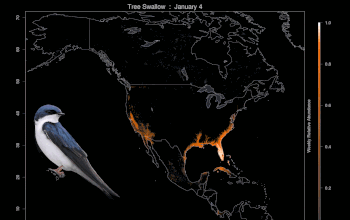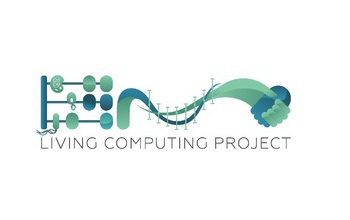All Images
News Release 16-003
NSF commits $30 million to expand the frontiers of computing
Expeditions in Computing grants span theoretical computer science, synthetic biology and computational sustainability
This material is available primarily for archival purposes. Telephone numbers or other contact information may be out of date; please see current contact information at media contacts.

This animation is an example of the application of computational sustainability techniques for predicting population abundances across broad spatial and temporal scales. The animation shows the annual cycle of the entire tree swallow population. The "hotter" the color, the higher relative abundance of the population at that location. This visualization allows us to see how tree swallows migrate across the continent and to identify the most important regions during each phase of the journey.
In the winter, tree swallows concentrate into distinct eastern and western sub-populations. As the spring migration begins, these populations explode northward and expand across the entire continent into their breeding grounds. The fall migration proceeds at a more leisurely pace as the populations return south, separating, and then concentrating into the Central Valley of California, the lower Mississippi River valley and Florida.
The animation was produced using the Spatio-Temporal Exploratory Model to predict population abundances across broad spatial and temporal scales. By relating local environmental features derived from NASA remote sensing data to observations of species from eBird (eBird.org), a citizen science program run by the Cornell Lab of Ornithology, the model can discover complex spatio-temporal patterns and make predictions at unsampled locations and times.
Credit: Daniel Fink, Cornell Lab. of Ornithology
Download the high-resolution GIF version of the image. (3.0 MB)
Use your mouse to right-click (Mac users may need to Ctrl-click) the link above and choose the option that will save the file or target to your computer.

The Living Computing Project will create a systematic set of guidelines to carefully measure and catalogue biological parts that can be used to engineer biological systems with predictable results.
Credit: Living Computing Project
Download the high-resolution JPG version of the image. (152.0 KB)
Use your mouse to right-click (Mac users may need to Ctrl-click) the link above and choose the option that will save the file or target to your computer.
_f.jpg)
A Network of Specifications: General insights must begin with experience specifying and implementing particular systems. The core goal of this Expedition is to create a set of interrelated specifications -- and artifacts connecting them -- drawn from the security-critical "middle layers" of software systems.
The diagram shows this network of deep specifications and the artifacts (implementations, translations, or proofs) connecting them, as the team envisions it at the end of the Expedition.
Credit: Andrew Appel, Princeton University
Download the high-resolution JPG version of the image. (1.2 MB)
Use your mouse to right-click (Mac users may need to Ctrl-click) the link above and choose the option that will save the file or target to your computer.
The Expeditions in Computing awards tackle some of the most challenging computing and information science and engineering issues today. See some of the research being carried out by Expeditions in Computing awardees in this video.
Credit: NSF


